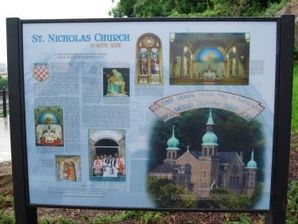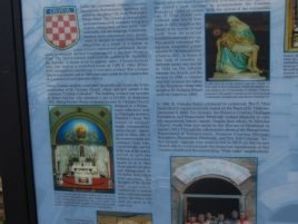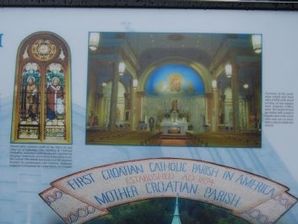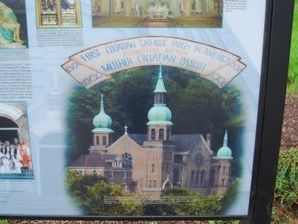St. Nicholas Church
In the late nineteenth century, Croatian immigrants fled economic hardship and settled in Allegheny City (now Pittsburgh's North Side). The Croatian immigrants were predominantly peasants living in a region comprised of one faith, one nationality, and one language. Community leaders were concerned their people were in danger of neglecting church obligations as a result of a failure to adjust to new customs and petitioned the diocese to establish the first Croatian parish in the New World in 1894. The church council dedicated the parish to St. Nicholas, the Traveler, in honor of its immigrant roots. Church services were first held in a converted house at 1546 E. Ohio Street. With immigration continuing, it was soon evident that a larger church was needed, and in 1899 plans were made for the construction of a permanent and grander edifice.
Many Croatian families contributed physically and financially to the construction of St. Nicholas Church, whose splendor earned it the nickname "Croatian Cathedral." The building contract was awarded to Robert McCain, who submitted a bid of $19,000. In September 1901, Bishop Richard Phelan dedicated the new St. Nicholas Church, designed in a Romanesque-influenced style by Pittsburgh architect, Frederick C. Sauer. Two towers of unequal height, surmounted by onion-shaped domes, stood at either side of the western façade and contained three bells. A third steeple, erected at the rear of the church, served to give the building a secondary façade on its E. Ohio Street (south) elevation and distinguished St. Nicholas from other area churches. The floorplan of the church was longitudinal, containing a central nave with colonnaded aisles on either side and an apse at its east end.
Shortly after the church was erected, a rectory was built opposite the church's west entrance to accommodate the Croatian Franciscan Order of priests. With the arrival of the automobile age, E. Ohio Street was widened from two to four lanes in 1921, requiring the church to be moved 20 feet north from its original foundation and eight feet up. The parish converted the adjacent Duquesne public school to St. Nicholas grammar school in 1931. In honor of Our Lady of Lourdes, an elaborate grotto was erected in 1944 on the hillside between the church and rectory. In 1950, a convent was built to house the sisters of the Franciscan Order who taught in St. Nicholas School until its closure in 1969.
In 1994, St. Nicholas Parish celebrated its centennial. The E. Ohio Street church was permanently closed on the Feast of St. Nicholas, December 6, 2004. For 14 years, the Preserve Croatian Heritage Foundation and Preservation Pittsburgh worked diligently to save this magnificent, historic church. Despite their efforts, St. Nicholas Church, North Side was razed by the Diocese of Pittsburgh in January of 2013. Through the collaborative efforts of the Pennsylvania Department of Transportation, Preserve Croatian Heritage Foundation, Preservation Pittsburgh, and Troy Hill Citizens, Inc., this historic signage was constructed in 2015 on the former church site to commemorate the historical significance of this Croatian church and surrounding "Mala Jaska" neighborhood.




